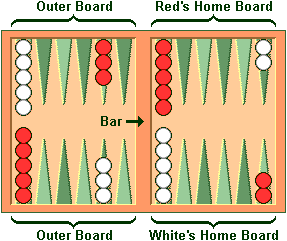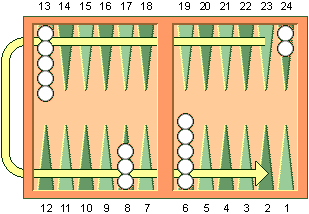Can a Person Roll Again After Doubles in Backgammon

| Setup | ||
| Backgammon is a game for two players, played on a board consisting of twenty-four narrow triangles called points. The triangles alternate in color and are grouped into iv quadrants of half-dozen triangles each. The quadrants are referred to as a actor'south abode lath and outer board, and the opponent'southward home board and outer board. The home and outer boards are separated from each other past a ridge down the center of the board called the bar.
The points are numbered for either actor starting in that player's habitation board. The outermost point is the twenty-four point, which is as well the opponent'due south one point. Each player has fifteen checkers of his own colour. The initial arrangement of checkers is: two on each player'due south twenty-four bespeak, five on each thespian's thirteen point, iii on each player'due south eight point, and five on each actor'due south half-dozen indicate. |

| Object of the Game | ||
| The object of the game is move all your checkers into your own home board and then bear them off. The first player to bear off all of their checkers wins the game.
|

| Movement of the Checkers |
| To beginning the game, each player throws a single die. This determines both the player to go first and the numbers to exist played. If equal numbers come, and so both players roll again until they whorl different numbers. The player throwing the higher number now moves his checkers according to the numbers showing on both die. Subsequently the get-go whorl, the players throw two die and alternate turns. The whorl of the die indicates how many points, or pips, the player is to move his checkers. The checkers are always moved frontward, to a lower-numbered point. The following rules employ:
|

| Hitting and Entering |
| A signal occupied by a single checker of either color is called a blot. If an opposing checker lands on a blot, the blot is hitting and placed on the bar. Any time a actor has one or more than checkers on the bar, his get-go obligation is to enter those checker(s) into the opposing home board. A checker is entered past moving it to an open up point corresponding to one of the numbers on the rolled dice. For example, if a actor rolls 4 and vi, he may enter a checker onto either the opponent'southward four point or six point, so long as the prospective point is not occupied by 2 or more than of the opponent's checkers. If neither of the points is open, the thespian loses his plough. If a player is able to enter some but not all of his checkers, he must enter as many every bit he can and and so forfeit the remainder of his turn. Afterwards the last of a player'due south checkers has been entered, whatsoever unused numbers on the dice must exist played, by moving either the checker that was entered or a different checker. |

| Begetting Off |
| Once a player has moved all of his xv checkers into his habitation lath, he may commence bearing off. A player bears off a checker past rolling a number that corresponds to the point on which the checker resides, and and then removing that checker from the board. Thus, rolling a 6 permits the actor to remove a checker from the six point. If there is no checker on the betoken indicated by the gyre, the player must make a legal move using a checker on a higher-numbered signal. If at that place are no checkers on higher-numbered points, the player is permitted (and required) to remove a checker from the highest point on which one of his checkers resides. A player is under no obligation to behave off if he can make an otherwise legal movement. A thespian must take all of his active checkers in his abode board in order to bear off. If a checker is hit during the bear-off process, the thespian must bring that checker back to his home lath earlier continuing to bear off. The first role player to bear off all fifteen checkers wins the game. |

| Doubling |
| Backgammon is played for an agreed stake per point. Each game starts at ane point. During the course of the game, a histrion who feels he has a sufficient reward may suggest doubling the stakes. He may practise this simply at the start of his ain plow and before he has rolled the dice. A player who is offered a double may refuse, in which case he concedes the game and pays 1 point. Otherwise, he must take the double and play on for the new college stakes. A player who accepts a double becomes the owner of the cube and only he may make the next double. Subsequent doubles in the same game are called redoubles. If a actor refuses a redouble, he must pay the number of points that were at stake prior to the redouble. Otherwise, he becomes the new owner of the cube and the game continues at twice the previous stakes. At that place is no limit to the number of redoubles in a game. |

| Gammons and Backgammons |
| At the terminate of the game, if the losing histrion has borne off at least ane checker, he loses but the value showing on the doubling cube (ane point, if at that place accept been no doubles). Nonetheless, if the loser has non borne off any of his checkers, he is gammoned and loses twice the value of the doubling cube. Or, worse, if the loser has non borne off any of his checkers and nonetheless has a checker on the bar or in the winner'due south abode board, he is backgammoned and loses iii times the value of the doubling cube. |

| Optional Rules |
| The following optional rules are in widespread employ.
|

| Irregularities |
|
Common Questions
- Tin I pass when it's my turn?
- Tin can I play one number in such a fashion as to avert playing the other?
- What if I can only play 1 number?
- Is hit-and-run allowed (likewise known as "option and laissez passer")?
- Is information technology ok to take more than five checkers on a point?
- Can I play low number first when bearing off?
- Is stalemate possible in backgammon?
Other Games
- How exercise yous play Acey-Deucey?
- What is Nackgammon?
- What is hyper-backgammon?
- What is long-gammon?
- What is roll-over?
- More games ...
Forms of Competition
- What is a chouette?
- What is match play?
![]()
Return to: Backgammon Galore
Source: https://www.bkgm.com/rules.html

 Both players have their own pair of dice and a dice cup used for shaking. A doubling cube, with the numerals 2, iv, eight, sixteen, 32, and 64 on its faces, is used to keep track of the current stake of the game.
Both players have their own pair of dice and a dice cup used for shaking. A doubling cube, with the numerals 2, iv, eight, sixteen, 32, and 64 on its faces, is used to keep track of the current stake of the game. 
0 Response to "Can a Person Roll Again After Doubles in Backgammon"
Post a Comment